Research on Failure Modes and Causes of 100-m-High Core Wall Rockfill Dams
Abstract
1. Introduction
2. An Overview of Earth–Rock Dam Failure Models
3. Statistical Analysis of Failure Modes in Core Wall Rockfill Dams above 100 Meters
3.1. Statistical Data Scope
3.2. Failure Modes between 1940 and 1980
3.3. Failure Modes after 1981
4. Typical Project Case Study
4.1. Project Overview
4.2. Situation of Failure Development
4.3. Methods of Analysis
4.4. Failure Analysis
4.4.1. Dam Crest Cracking Study
Uneven Deformation
Material Influence
Impact of Water Storage
4.4.2. Dam Seepage Study
4.4.3. Gallery Cracking Study
5. Discussion and Conclusions
Author Contributions
Funding
Data Availability Statement
Conflicts of Interest
References
- Cooke, J.B. Progress in Rockfill Dams. J. Geotech. Eng. 1984, 110, 1381–1414. [Google Scholar] [CrossRef]
- Mahinroosta, R.; Alizadeh, A.; Gatmiri, B. Simulation of collapse settlement of first filling in a high rockfill dam. Eng. Geol. 2015, 187, 32–44. [Google Scholar] [CrossRef]
- Chen, C.; Lu, X.; Li, J.; Chen, J.; Zhou, Z.; Pei, L. A novel settlement forecasting model for rockfill dams based on physical causes. Bull. Eng. Geol. Environ. 2021, 80, 7973–7988. [Google Scholar] [CrossRef]
- Rahmani, H.; Panah, A.K. Effect of particle size and saturation conditions on the breakage factor of weak rockfill materials under one-dimensional compression testing. Geomech. Eng. 2020, 21, 315–326. [Google Scholar]
- Rasskazov, L.N.; Yadgorov, E.K.; Nikolaev, V.B. Field Observations of Soil Settlements, Displacements, and Pore Pressure in Dams. Power Technol. Eng. 2018, 51, 611–620. [Google Scholar] [CrossRef]
- Zhang, H.; Chen, J.; Hu, S.; Xiao, Y.; Zeng, B. Deformation Characteristics and Control Techniques at the Shiziping Earth Core Rockfill Dam. J. Geotech. Geoenviron. Eng. 2016, 142, 04015069. [Google Scholar]
- Deng, G.; Cao, K.; Chen, R.; Zhang, X.; Yin, Q.; Zhou, H. A simple approach to evaluating leakage through thin impervious element of high embankment dams. Environ. Earth Sci. 2018, 77, 25. [Google Scholar] [CrossRef]
- Xu, G.; Han, X.; Zhang, Y.; Wu, C. Dam Crack Image Detection Model on Feature Enhancement and Attention Mechanism. Water 2023, 15, 64. [Google Scholar] [CrossRef]
- Zhang, H.; Jing, Y.; Chen, J.; Gao, Z.; Xu, Y. Characteristics and causes of crest cracking on a high core-wall rockfill dam: A case study. Eng. Geol. 2022, 297, 106488. [Google Scholar] [CrossRef]
- Qiu, H.; Hu, R.; Huang, Y.; Gwenzi, W. Detection and Quantification of Dam Leakages Based on Tracer Tests: A Field Case Study. Water 2022, 14, 1448. [Google Scholar] [CrossRef]
- Pan, L.; Wu, B.; Wang, D.; Zhou, X.; Wang, L.; Zhang, Y. Study on Impoundment Deformation Characteristics and Crack of High Core Rockfill Dam Based on Inversion Parameters. Water 2024, 16, 188. [Google Scholar] [CrossRef]
- Zhang, Y.; Wang, W.; Zhu, Y. Investigation on conditions of hydraulic fracturing for asphalt concrete used as impervious core in dams. Constr. Build. Mater. 2015, 93, 775–781. [Google Scholar] [CrossRef]
- Echávez, G. Risk Analysis of Cavitation in Hydraulic Structures. World J. Eng. Technol. 2021, 9, 614–623. [Google Scholar] [CrossRef]
- Zhang, X.; Wang, C.Y.; Wong, H.; Jiang, T.; Dong, J. Modeling dam deformation in the early stage of internal seepage erosion—Application to the Teton Dam, Idaho, before the 1976 incident. J. Hydrol. 2022, 605, 127378. [Google Scholar] [CrossRef]
- Feng, R.; He, Y.L.; Cao, X.X. Different Deformation Patterns in High Core Wall Rockfill Dams: A Case Study of the Maoergai and Qiaoqi Dams. Adv. Civ. Eng. 2019, 2019, e7069375. [Google Scholar] [CrossRef]
- Fu, Z.; Chen, S.; Ji, E.; Fu, Z.; Chen, S.; Ji, E. Practices in Constructing High Rockfill Dams on Thick Overburden Layers. In Dam Engineering; IntechOpen: London, UK, 2018. [Google Scholar] [CrossRef]
- Wen, L.; Chai, J.; Xu, Z.; Qin, Y.; Li, Y. A statistical review of the behaviour of concrete-face rockfill dams based on case histories. Géotechnique 2018, 68, 749–771. [Google Scholar] [CrossRef]
- Liu, Q.; Lu, G.; Dong, J. Prediction of landslide displacement with step-like curve using variational mode decomposition and periodic neural network. Bull. Eng. Geol. Environ. 2021, 80, 3783–3799. [Google Scholar] [CrossRef]
- Nie, L.; Wang, H.; Xu, Y. Application of the arctangent function model in the prediction of ground mining subsidence deformation: A case study from Fushun City, Liaoning Province, China. Bull. Eng. Geol. Environ. 2017, 76, 1383–1398. [Google Scholar] [CrossRef]
- Lawton, E.C.; Fragaszy, R.J.; Hetherington, M.D. Review of Wetting-Induced Collapse in Compacted Soil. J. Geotech. Eng. 1992, 118, 1376–1394. [Google Scholar] [CrossRef]
- Zhou, X.; Chi, S.; Jia, Y.; Shao, X. A new wetting deformation simulation method based on changes in mechanical properties. Comput. Geotech. 2020, 117, 103261. [Google Scholar] [CrossRef]
- Yu, S.; Zhang, Q.; Chen, Z.; Hao, J.; Wang, L.; Li, P.; Zhong, Q. Study of the Sheyuegou dam breach—Experience with the post-failure investigation and back analysis. Eng. Fail. Anal. 2021, 125, 105441. [Google Scholar] [CrossRef]
- ICOLD. Dam Failures Statistical Analysis; International Commission on Large Dams: Paris, France, 1995. [Google Scholar]
- ICOLD. Deterioration of Dams and Reservoirs; International Commission on Large Dams: Paris, France, 1983. [Google Scholar]
- ICOLD. Lessons from Dam Incidents; International Commission on Large Dams: Paris, France, 1974. [Google Scholar]
- Zhong, Q.M.; Chen, S.S.; Deng, Z.; Mei, S.A. Prediction of Overtopping-Induced Breach Process of Cohesive Dams. J. Geotech. Geoenviron. Eng. 2019, 145, 04019012. [Google Scholar] [CrossRef]
- Editorial Committee of China Water Resources Yearbook. China Water Resources Yearbook 2020; China Water & Power Press: Beijing, China, 2020. [Google Scholar]
- Sheng, J.; Li, H.; Sheng, T. Statistical analysis of dam failure and its loss of life in China. Hydro-Sci. Eng. 2023, 1–15. [Google Scholar] [CrossRef]
- Deng, G.; Ding, Y.; Zhang, Y.; Zhang, Y.; Huang, W. Evolution of earth core embankment dams along with the development of configuration and materials. J. China Inst. Water Resour. Hydropower Res. 2021, 19, 411–423. [Google Scholar]
- Lehner, B.; Liermann, C.R.; Revenga, C.; Vörösmarty, C.; Fekete, B.; Crouzet, P.; Wisser, D. High-resolution mapping of the world’s reservoirs and dams for sustainable river-flow management. Front. Ecol. Environ. 2011, 9, 494–502. [Google Scholar] [CrossRef] [PubMed]
- Mulligan, M.; van Soesbergen, A.; Sáenz, L. GOODD, a global dataset of more than 38,000 georeferenced dams. Sci. Data 2020, 7, 31. [Google Scholar] [CrossRef] [PubMed]
- Wang, J.; Walter, B.A.; Yao, F.; Song, C.; Ding, M.; Maroof, A.S.; Wada, Y. GeoDAR: Georeferenced global Dams and Reservoirs dataset for bridging attributes and geolocations. Earth Syst. Sci. Data 2022, 14, 1869–1899. [Google Scholar] [CrossRef]
- Zhang, A.T.; Gu, V.X. Global Dam Tracker: A database of more than 35,000 dams with location, catchment, and attribute information. Sci. Data 2023, 10, 111. [Google Scholar] [CrossRef] [PubMed]
- Sherard, J.L. Lessons from the Teton Dam failure. Eng. Geol. 1987, 24, 239–256. [Google Scholar] [CrossRef]
- Cetin, H.; Laman, M.; Ertunç, A. Settlement and slaking problems in the world’s fourth largest rock-fill dam, the Ataturk Dam in Turkey. Eng. Geol. 2000, 56, 225–242. [Google Scholar] [CrossRef]
- Zhou, X.; Chi, S.; Wang, M.; Jia, Y. Study on wetting deformation characteristics of coarse granular materials and its simulation in core-wall rockfill dams. Int. J. Numer. Anal. Methods Geomech. 2020, 44, 851–873. [Google Scholar] [CrossRef]
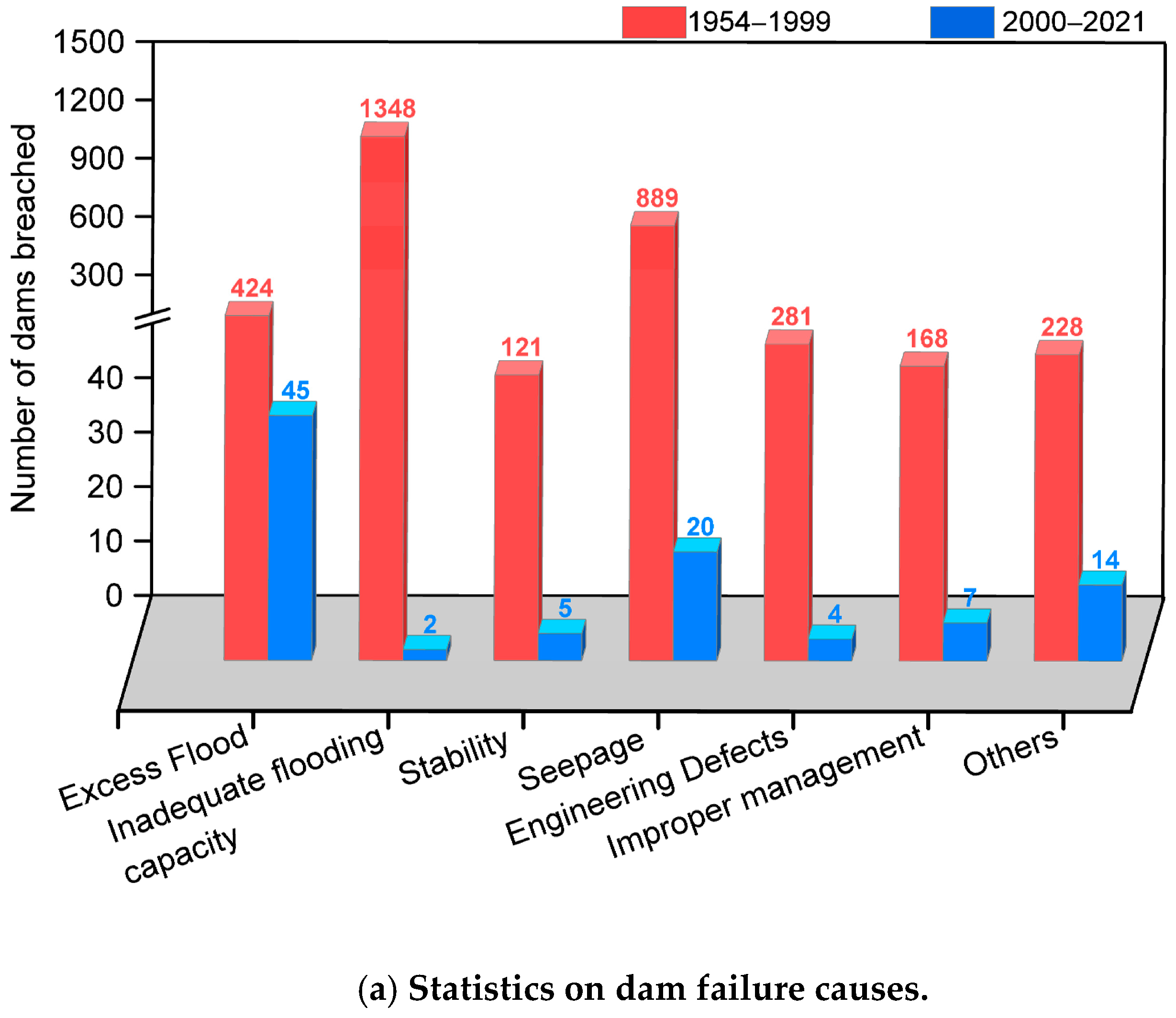
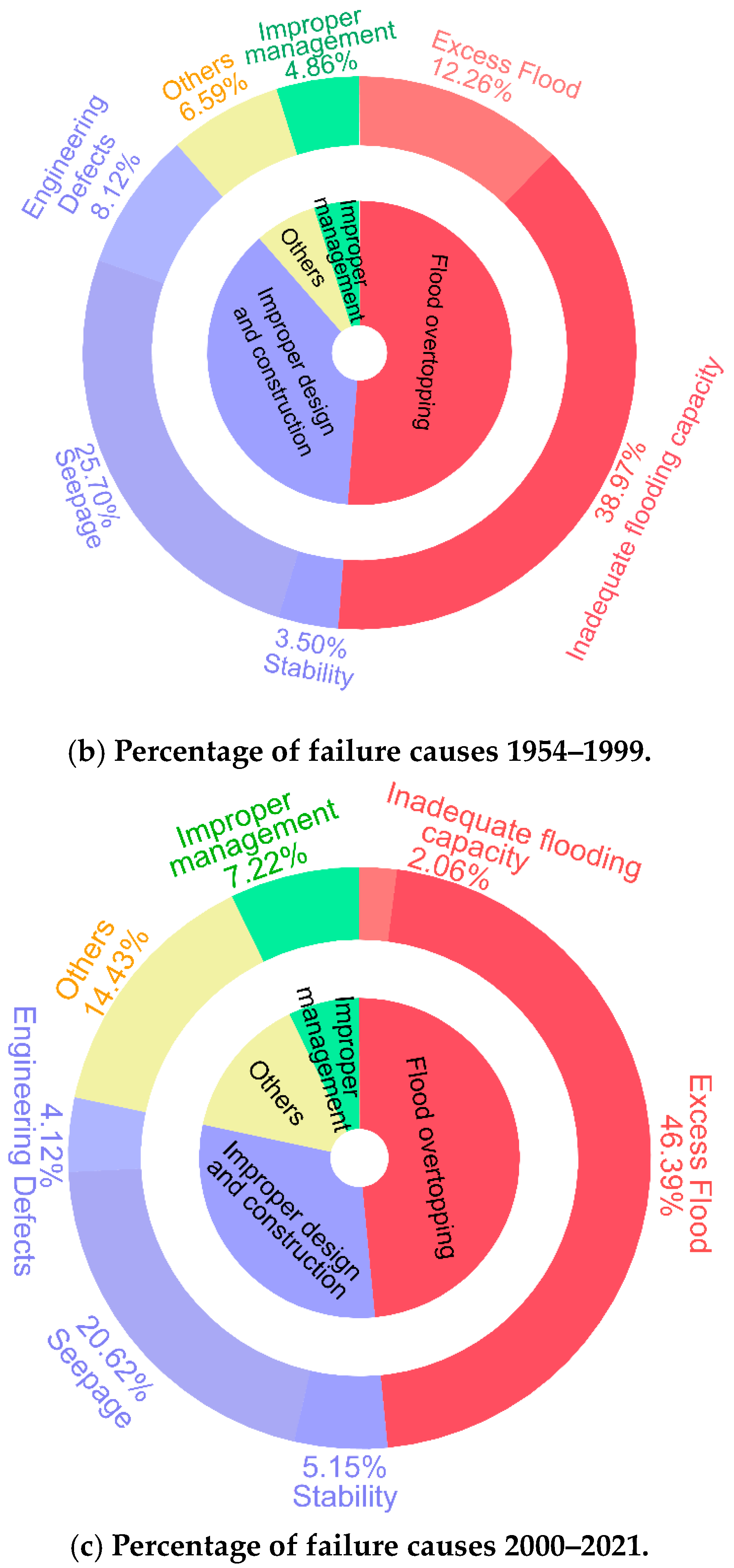
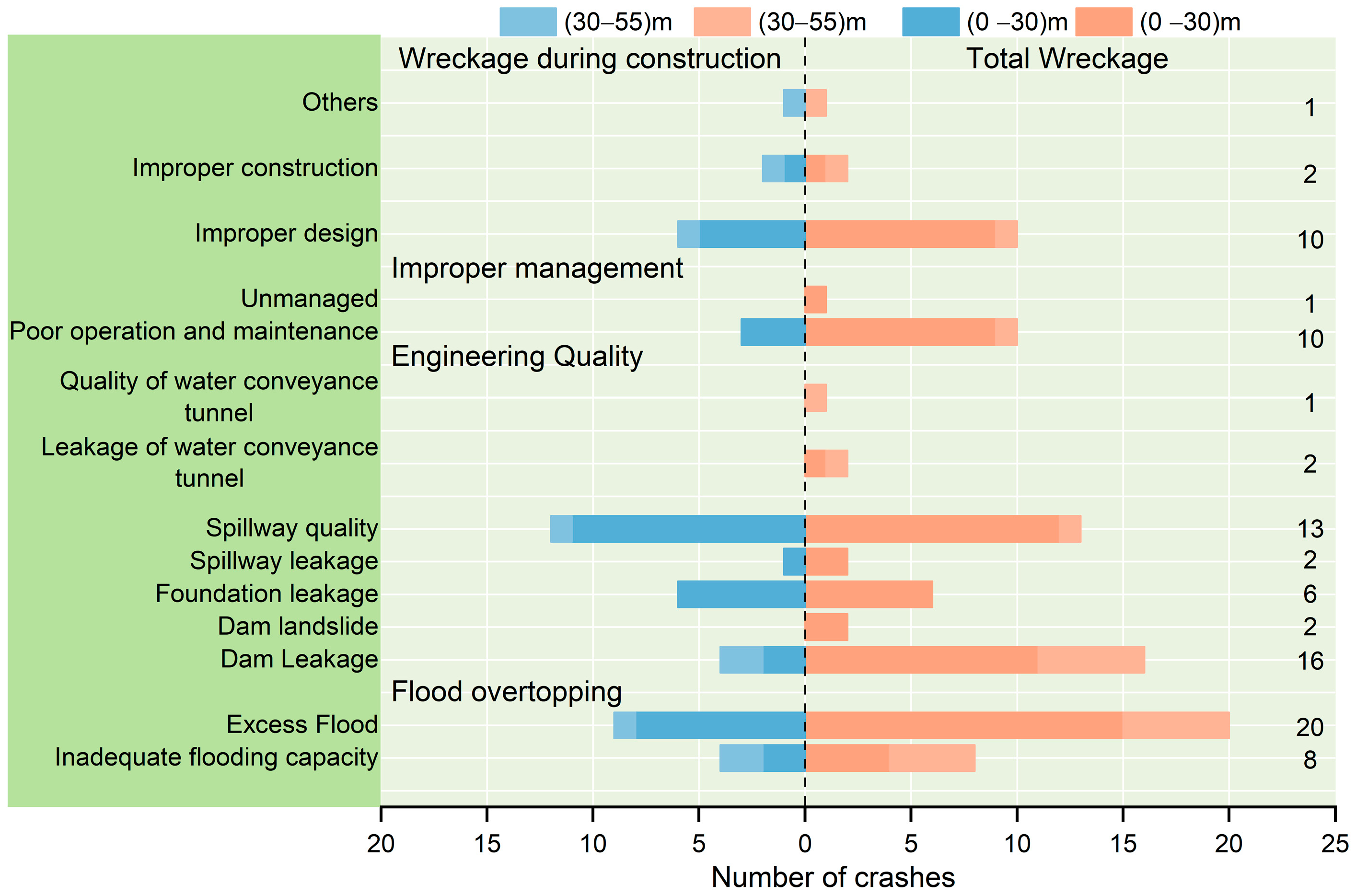
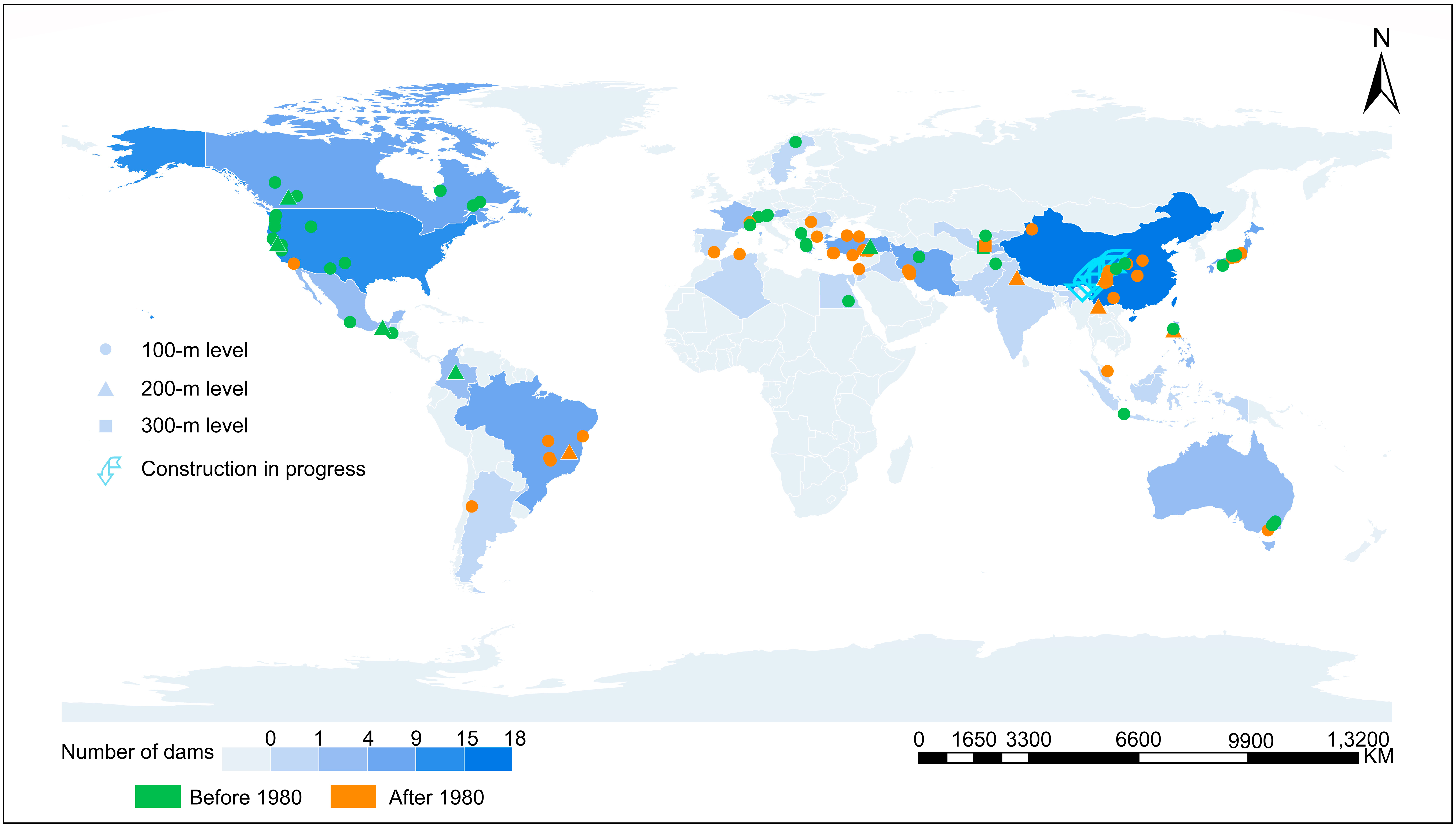

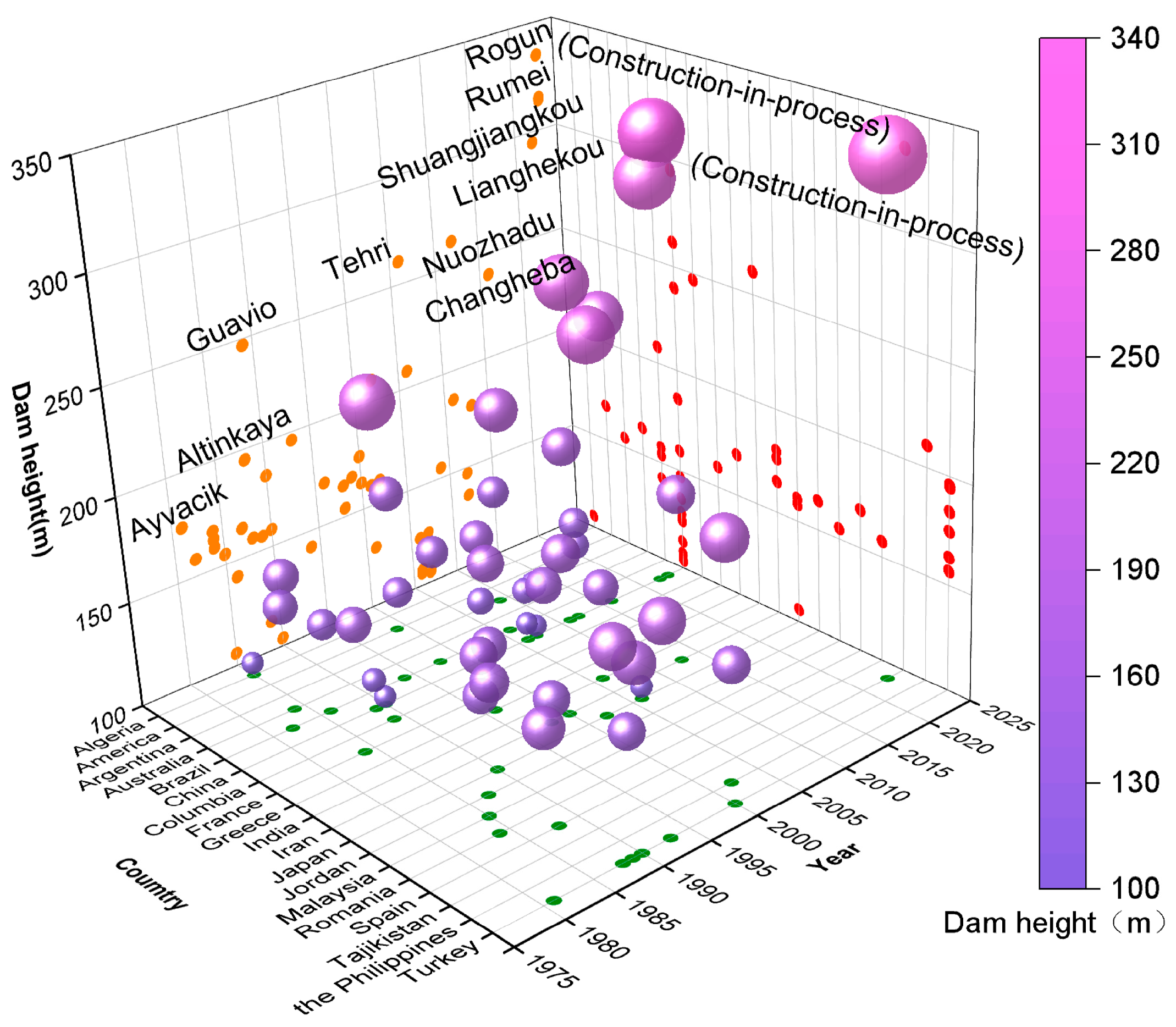
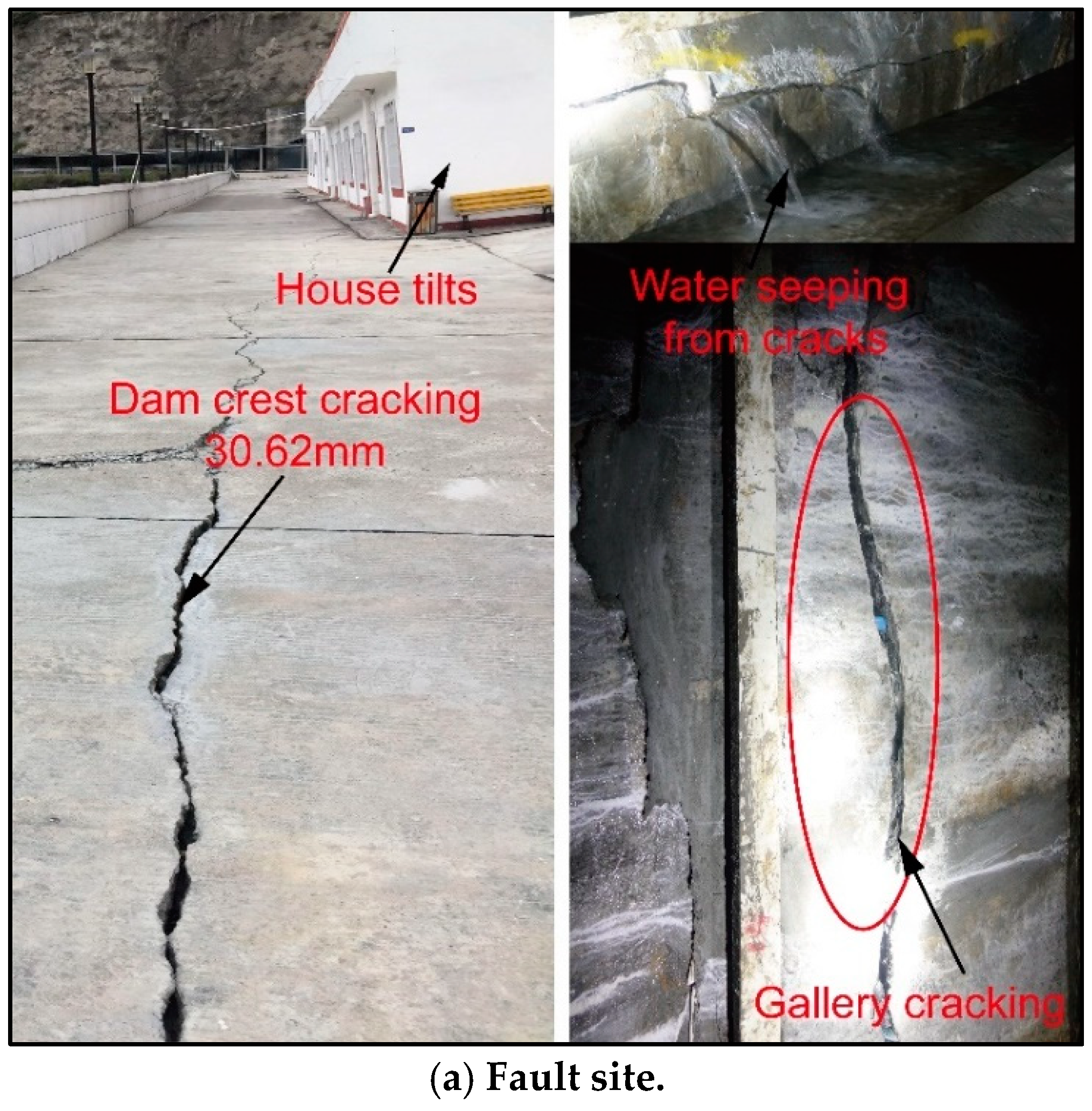
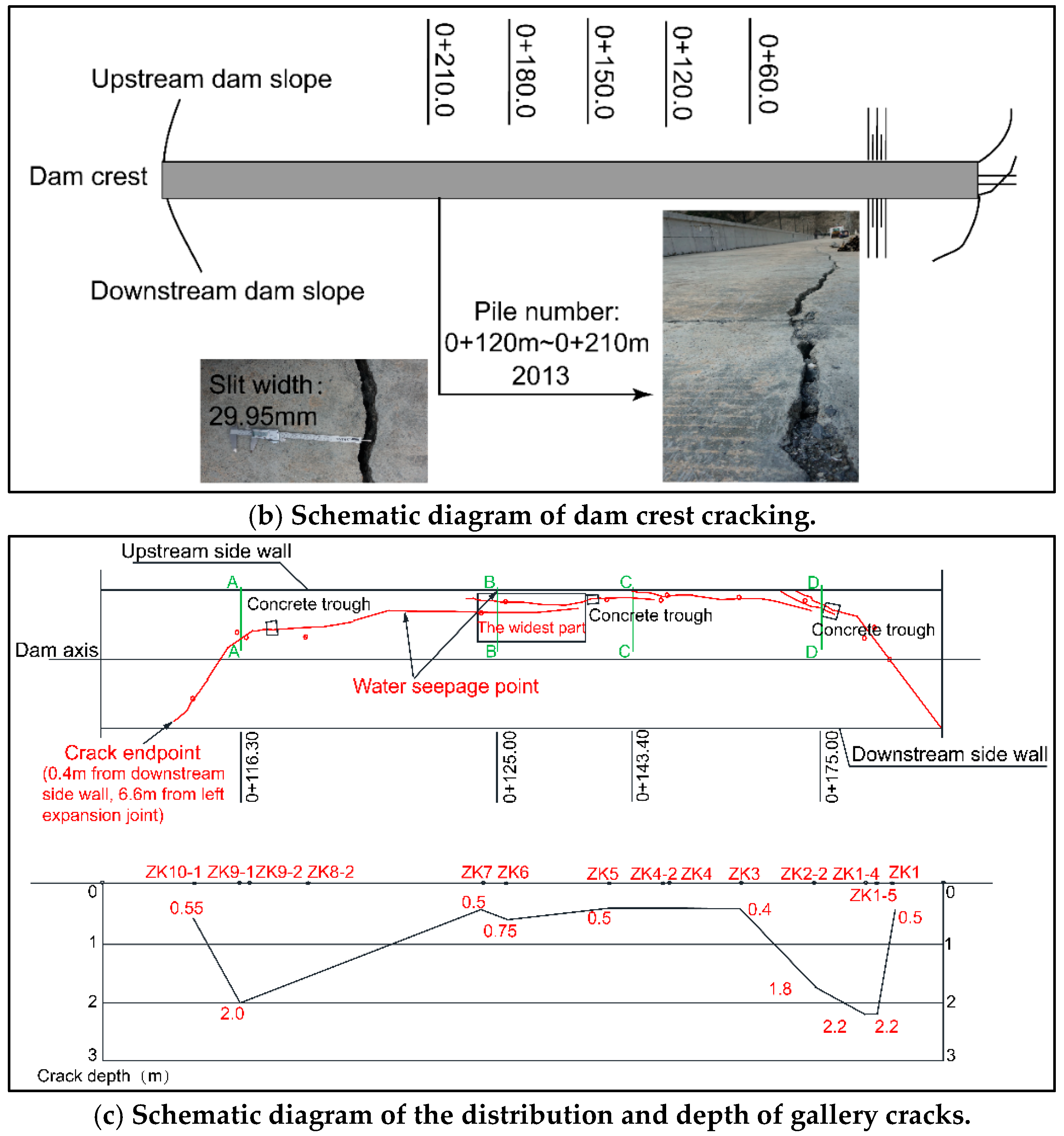
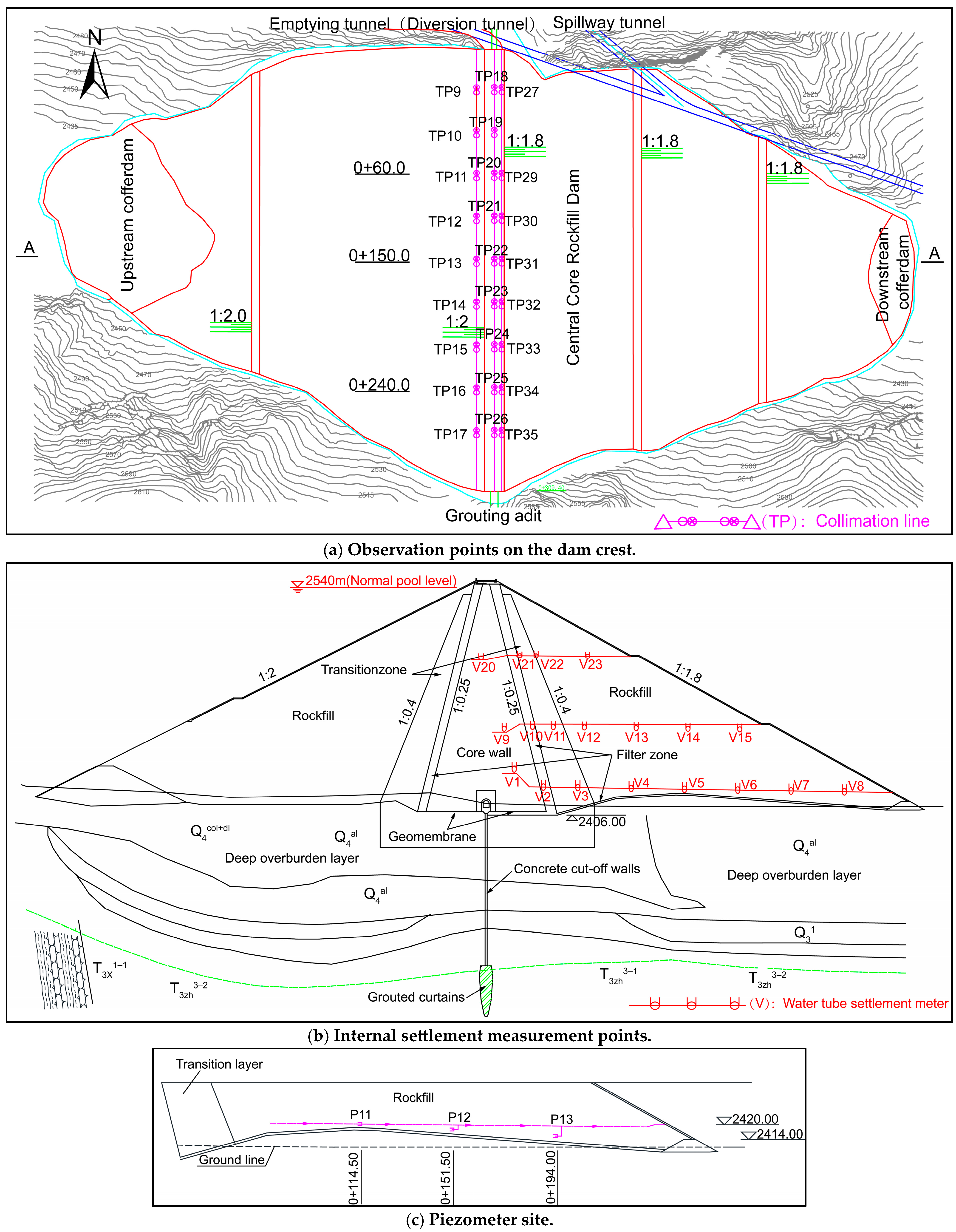


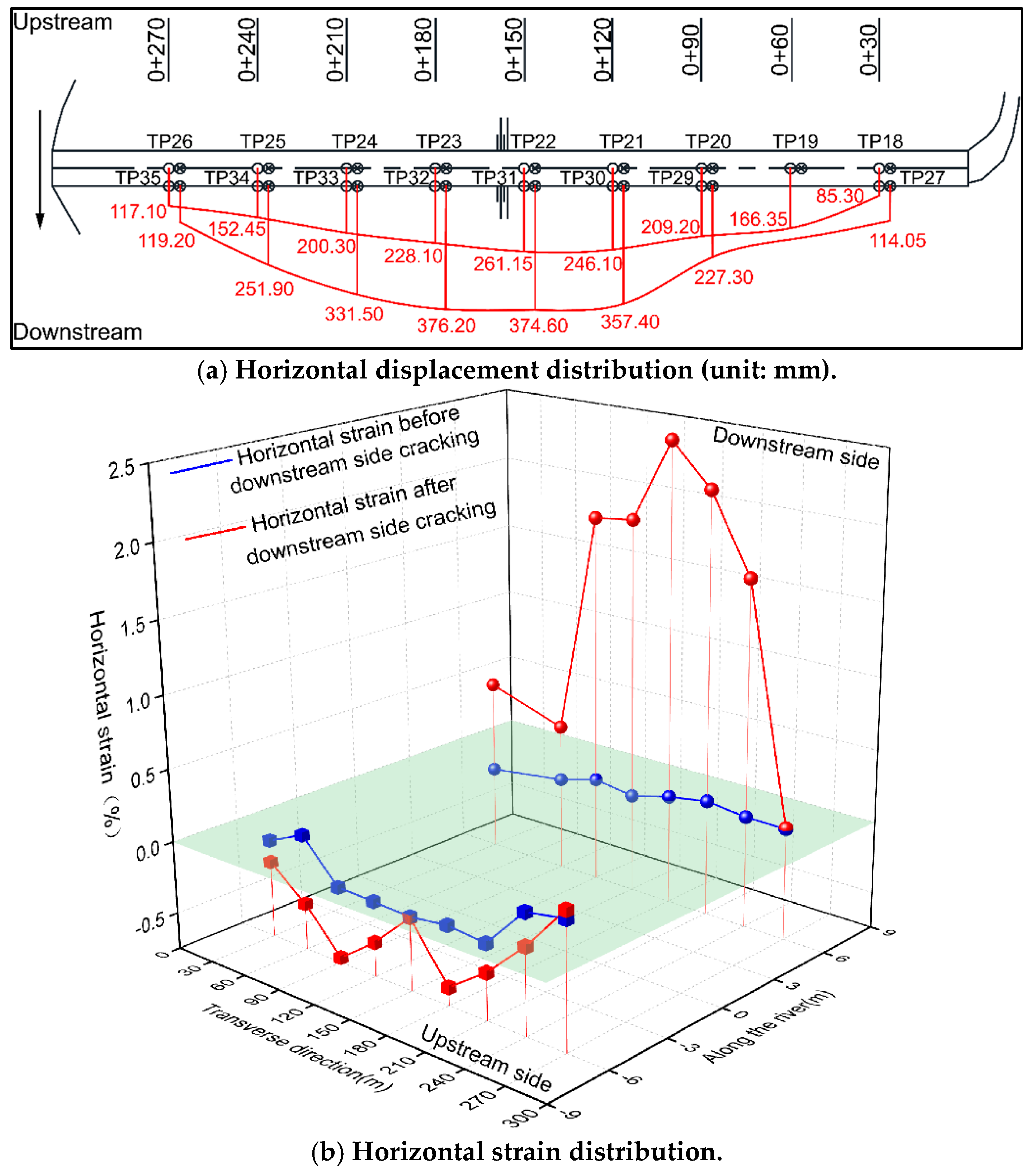

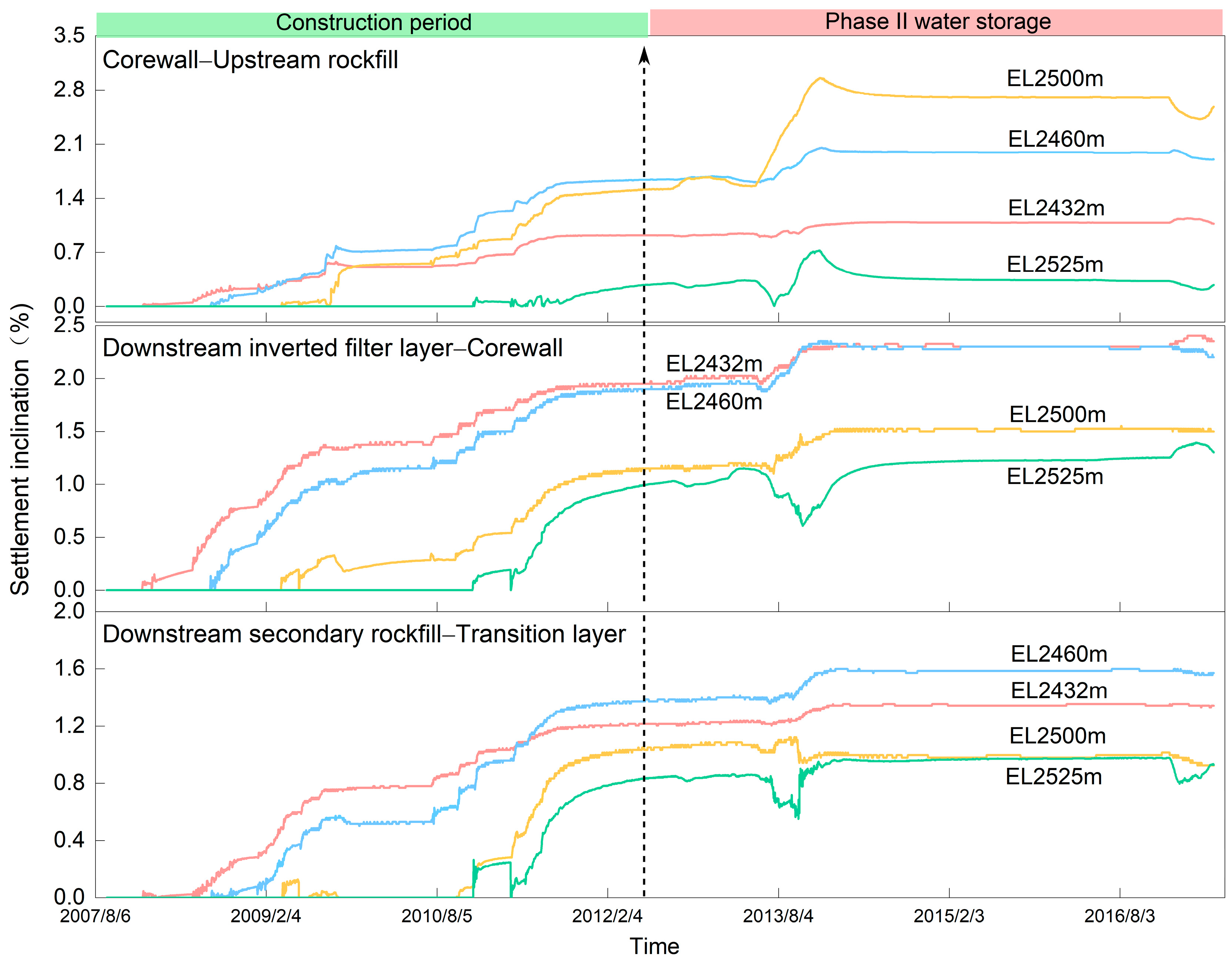

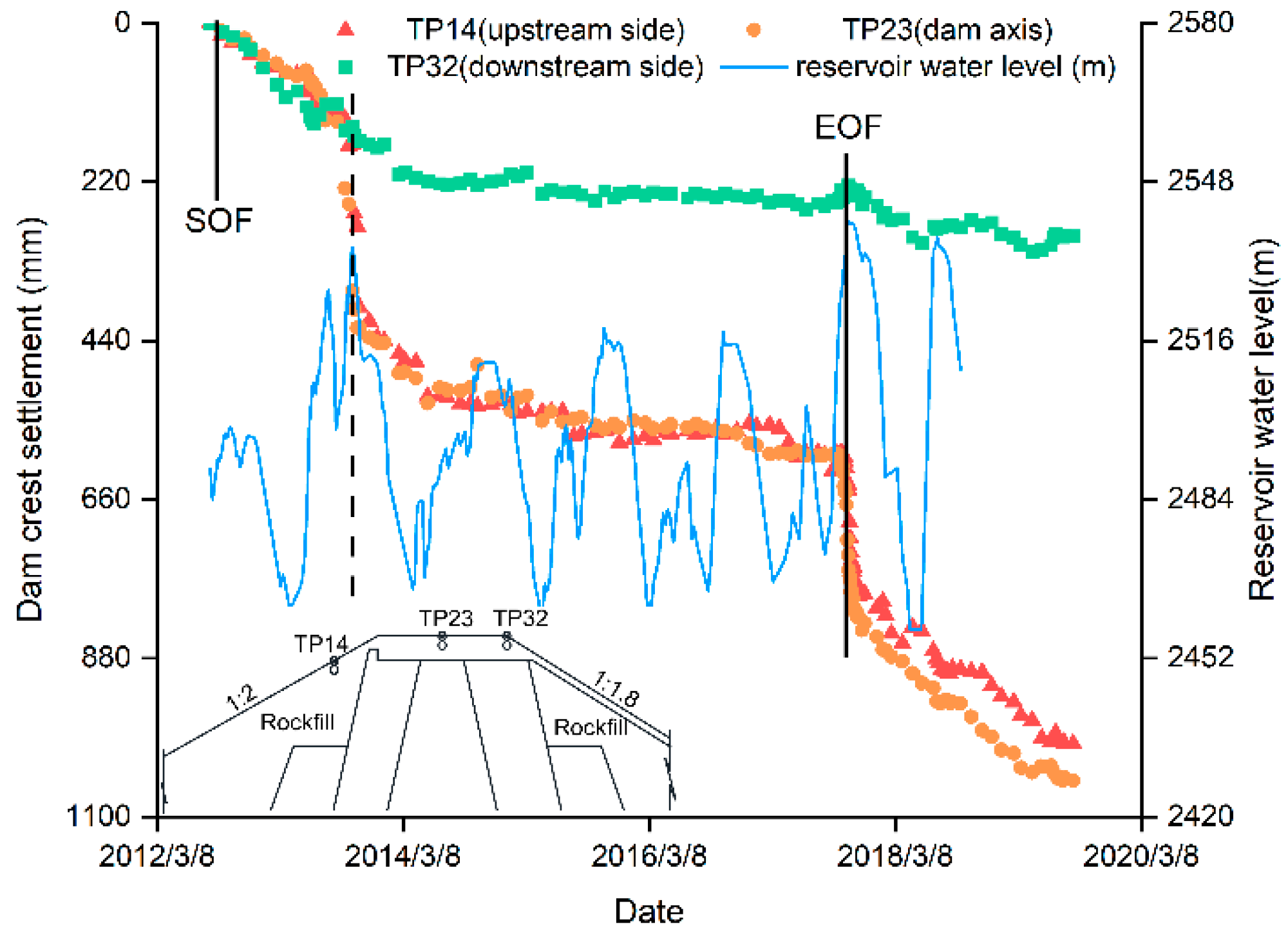


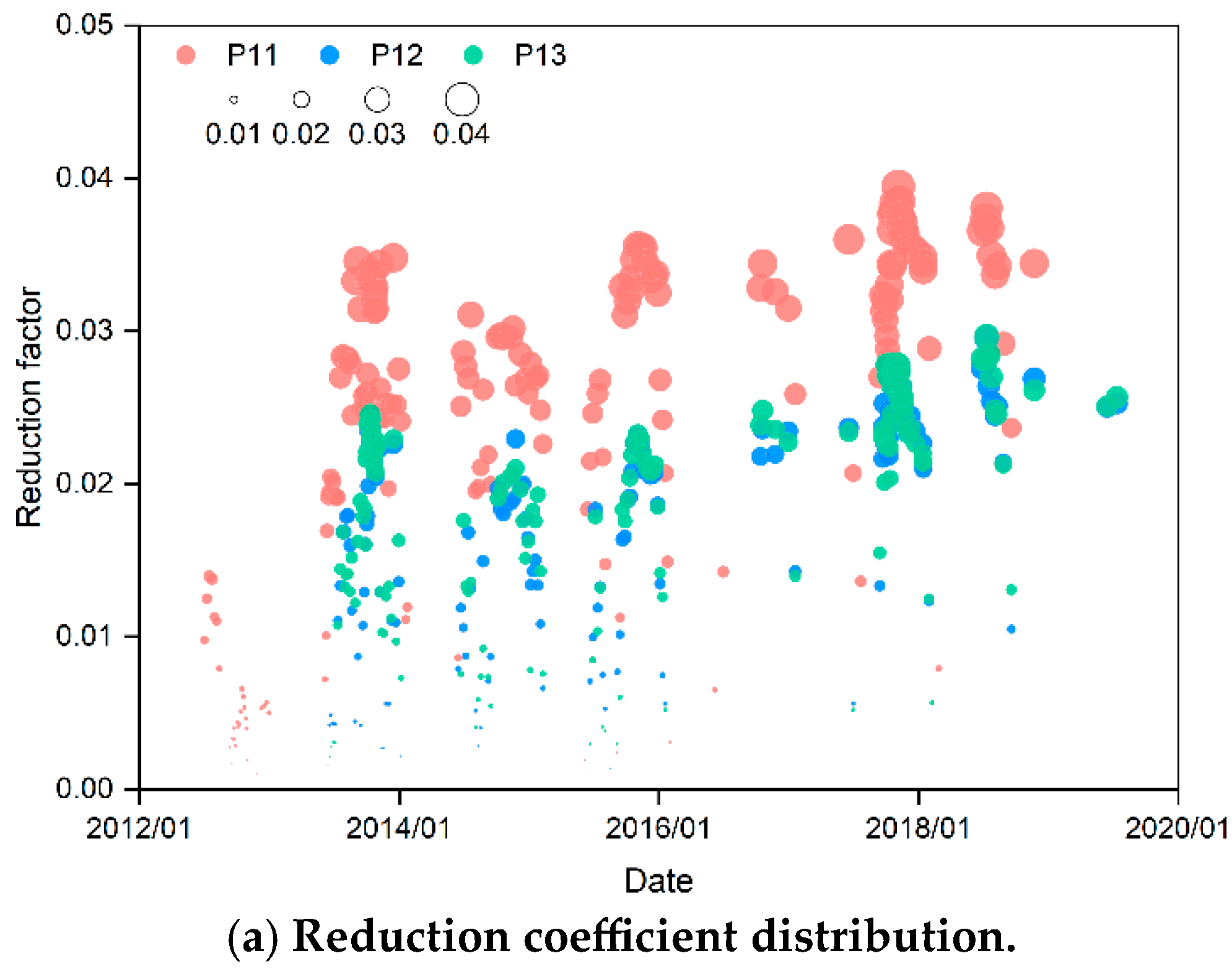

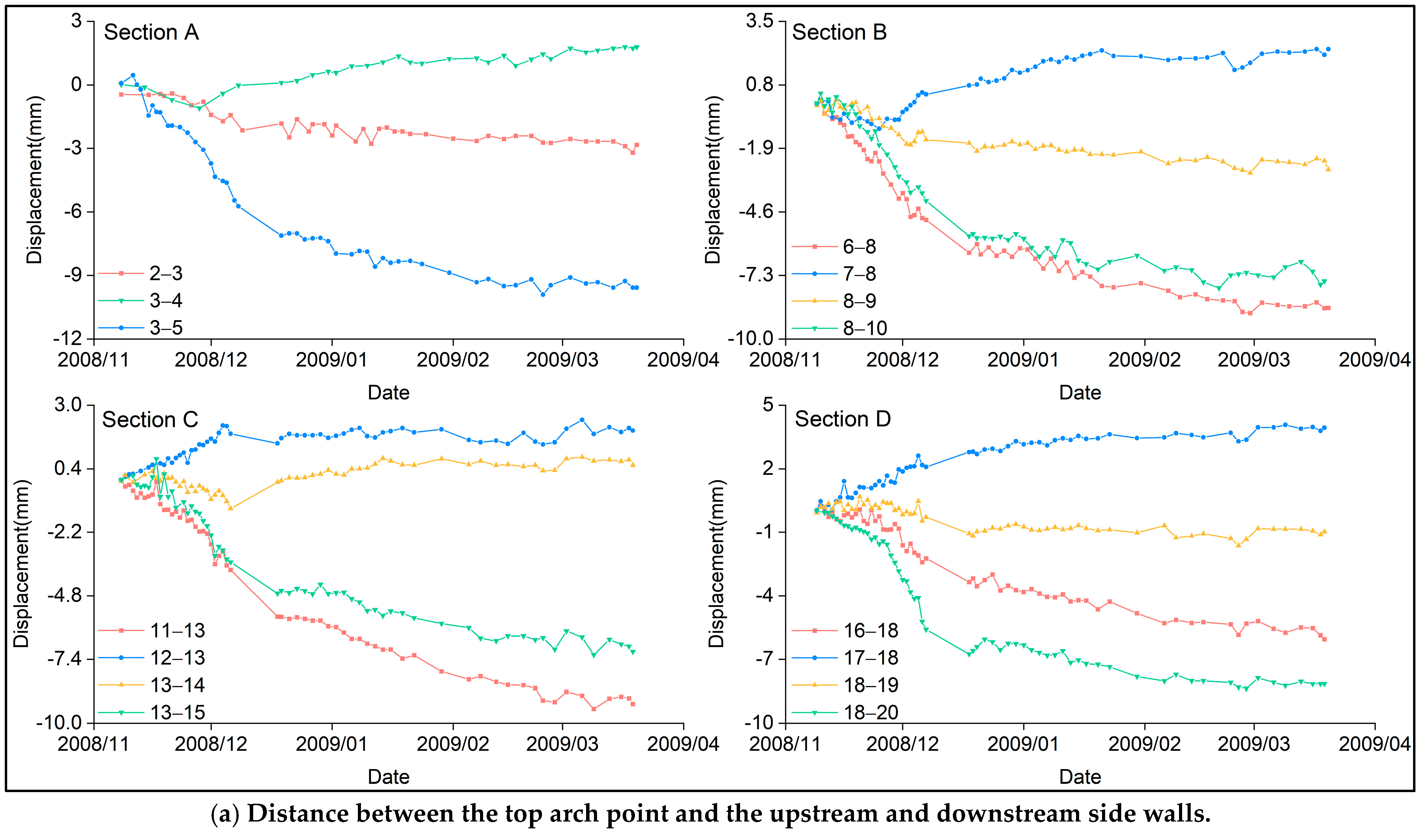
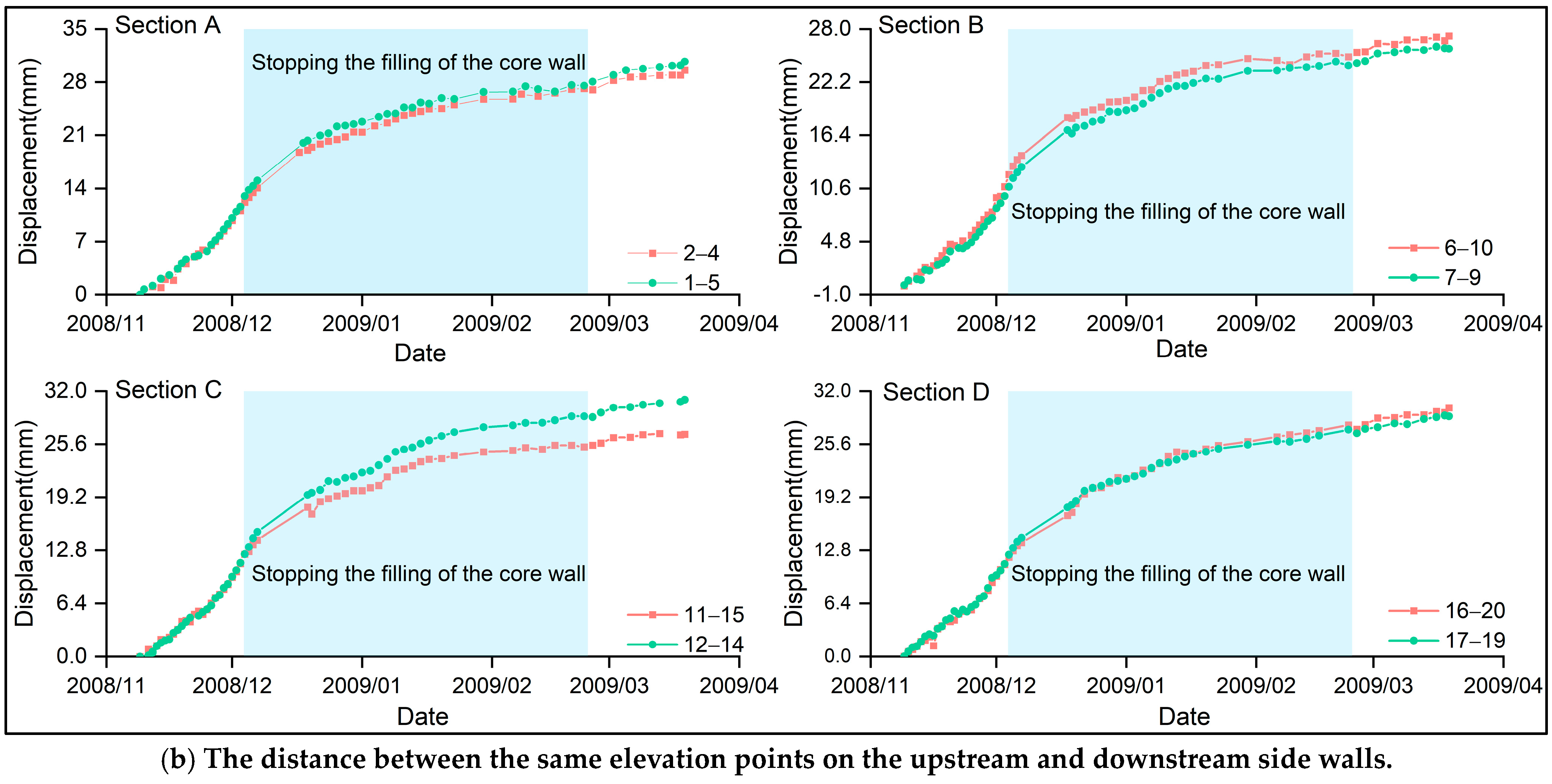

| Dam (Height) | Foundation Characteristics | Failure Stage | Cases | Failure Mode |
|---|---|---|---|---|
| Bikou (105.3 m) | F, 20~34 m; J | Operating period | The earthquake in 2008 caused damage to the dam’s surface and resulted in increased seepage in the grout galleries on both banks. | Dam cracking, Seepage around both banks |
| Djatiluhur (112 m) | F | Construction period | The dam’s uneven subsidence causes longitudinal cracking. | Dam cracking |
| Mud Mountain (131.7 m) | F, 2 m; J | Construction period | Cracks parallel to the dam axis appear between the core wall and the transition layer. | Dam cracking, Core wall splitting |
| Operating period | The seepage water head in the core wall rises and falls in time with the reservoir water level, causing water seepages at the downstream dam toe. | |||
| Hell Hole (125 m) | - | Construction period | After a heavy rain in 1964, the top of the construction section’s rockfill slid along with the downstream rockfill, forming a 128-m-wide breach. | Dam foundation seepage |
| Teton (126.5 m) | J | Initial storage period | A whirlpool formed in the reservoir near pile number 0 + 14, and a sunken hole appeared near the dam crest on the downstream dam surface. The dam collapse took about 5 h from the discovery of muddy water. | Dam cracking, Core wall splitting, Dam foundation seepage |
| Tarbela (143 m) | F, 210~230 m | Construction period | Three sinkholes were discovered on the dam slope of the No. 1 auxiliary dam when the reservoir water level dropped. | Dam cracking |
| Infiernillo (148 m) | F, 8 m | Initial storage period | Cracks appeared on both abutments of the dam shortly after the water was impounded. | Dam cracking |
| Gepatsch (153 m) | F, 122 m | Initial storage period | The dam shell has significant collapse deformation, a strong core wall arching effect, and severe longitudinal cracks on the dam crest. | Dam crest cracking, Dam-slope landslide |
| Operating period | Several bank slopes upstream of the dam deformed by more than ten meters. | |||
| La Grande2 (160 m) | F, 20 m | Initial storage period | Longitudinal cracks at the junction of the core wall and the dam shell. | Dam cracking |
| Kremasta (165 m) | J | Operating period | Seepage developed in the dam abutment foundation and worsened over time. | Dam foundation seepage |
| Portage Mountain (183 m) | J | Operating period | There were collapse pits on the dam crest, concentrated seepage channels in the core wall, and large collapse pits on the tops of the channels. | Core wall splitting |
| Dam (Height) | Foundation Characteristics | Failure Stage | Cases | Failure Mode |
|---|---|---|---|---|
| Lubuge (103.8 m) | F, 5 m; J | Construction Period, Operating period | There have been seepage issues since it went into service. Cracks appeared in the traffic drainage gallery in 2006. | Gallery cracking, Dam seepage |
| Shitouhe (114 m) | F, 4~10 m; J | Construction Period | Several concentrated seepages are produced by the right dam abutment rock mass. As the reservoir water level rises, the amount of seepage increases significantly. | Dam abutment cracking, Seepage around both banks |
| Qiaoqi (125.5 m) | F, 57~65 m; J | Initial storage period | The dam foundation gallery’s structural joints seeped in 2007. | Dam foundation seepage |
| Shiziping (136 m) | F, 90~102 m; J | Initial storage period | The 2008 earthquake caused penetrating cracks in the grouting gallery floor. Longitudinal cracks appeared on the dam cresy in 2013. | Gallery cracking, Dam crest cracking |
| Maoergai (147 m) | F, 30~50 m; J | Initial storage period | A longitudinal crack appeared on the dam crest in 2012, and water seepage occurred in the observation room on the downstream dam surface. | Dam crest cracking, Suspected core wall splitting |
| Xiaolangdi (154 m) | F, 30~40 m; J | Initial storage period | As the water level rises, so does the amount of water seeping into the dam body and dam foundation. | Dam foundation seepage |
| Operating period | On the inside of the downstream curb, there is a 100-m-long longitudinal crack. | Dam crest cracking | ||
| Emboreasco (158 m) | - | Operating period | Cracks appeared at heights of exceeding 120 m. | Dam cracking |
| Ataturk (169 m) | J | Initial storage period | The dam crest experienced significant settlement, resulting in longitudinal cracks. | Dam crest cracking |
| Soleyman (177 m) | - | Initial storage period | Separation of the core wall and the backfilter layer, as well as the backfilter layer and the dam shell rubble. | Dam crest cracking |
| Pubugou (186 m) | F, 40~60 m; J | Initial storage period | Longitudinal cracks appeared on the dam crest and the gallery cracked in 2010. | Dam crest cracking, Gallery cracking |
| Changheba (240 m) | F, 60~70 m; J | Construction Period | 16 cracks appeared on the upper part of the right dam abutment slope in 2010. | Dam abutment cracking (may cause seepage) |
| Earth and Rock Material | Density /(103 kg/m3) | Shear Strength | Duncan-Chang E-Bmodel | |||||||
|---|---|---|---|---|---|---|---|---|---|---|
| φ/(°) | Δφ/(°) | c/(Kpa) | Kur | Rf | K | n | Kb | m | ||
| Upstream rockfill | 2.14 | 44.29 | 11.04 | 0 | 2000 | 0.79 | 1000 | 0.28 | 668.49 | 0.1 |
| Transition material | 2.1 | 54.1 | 13.92 | 0 | 1980 | 0.82 | 990 | 0.112 | 462.18 | 0.1 |
| Antifiltration material | 2.16 | 42 | 10.2 | 0 | 1700 | 0.74 | 850 | 0.28 | 414.06 | 0.2 |
| Core wall material | 2.28 | 28.9 | 0 | 66 | 988 | 0.82 | 494 | 0.4 | 207.7 | 0.4 |
| Downstream rockfill II | 2.17 | 46.2 | 6.6 | 0 | 1640 | 0.83 | 820 | 0.28 | 421.35 | 0.22 |
| Downstream rockfill I | 2.15 | 52.1 | 9 | 0 | 2200 | 0.79 | 1100 | 0.35 | 668.49 | 0.22 |
| Covering layer ⑤ | 1.41 | 41.8 | 0 | 20 | 1600 | 0.81 | 965 | 0.64 | 889.24 | 0.27 |
| Covering layer ④-2 | 1.38 | 35 | 0 | 10 | 1400 | 0.76 | 600 | 0.42 | 889.24 | 0.27 |
| Covering layer ④-1 | 1.06 | 28 | 0 | 30 | 800 | 0.76 | 400 | 0.52 | 889.24 | 0.27 |
| Covering layer ③-2 | 1.38 | 32 | 0 | 0 | 900 | 0.76 | 450 | 0.62 | 889.24 | 0.27 |
| Covering layer ③-1 | 1.38 | 35 | 0 | 0 | 1400 | 0.76 | 950 | 0.42 | 889.24 | 0.27 |
| Covering layer ② | 1.06 | 26 | 0 | 40 | 500 | 0.75 | 300 | 0.46 | 889.24 | 0.27 |
| Covering layer ① | 1.41 | 38 | 0 | 0 | 1600 | 0.75 | 1100 | 0.42 | 889.24 | 0.27 |
| Earth and Rock Material | α (10−2) | b (10−4) | c (10−4) | d (10−3) | m1 | m2 | m3 |
|---|---|---|---|---|---|---|---|
| Upstream rockfill | 0.893 | 1.055 | 1.055 | 1.470 | 0.514 | 0.416 | 0.427 |
| Antifiltration material | 0.912 | 1.172 | 1.172 | 1.659 | 0.721 | 0.420 | 0.549 |
| Transition material | 0.893 | 1.172 | 1.172 | 1.659 | 0.679 | 0.409 | 0.551 |
| Core wall material | 0.638 | 2.134 | 2.134 | 3.705 | 0.996 | 0.679 | 0.518 |
| Downstream rockfill II | 0.638 | 0.2 | 0.2 | 0.909 | 0.848 | 0.455 | 0.542 |
| Downstream rockfill I | 1.1 | 0.466 | 0.466 | 1.009 | 0.408 | 0.365 | 0.482 |
| Covering layer | 0.986 | 0.518 | 0.518 | 1.121 | 0.848 | 0.455 | 0.542 |
| Upstream Rockfill | Core Wall—Upstream Rockfill | Core Wall | Downstream Rockfill—Core Wall | Downstream Rockfill | |
|---|---|---|---|---|---|
| Phase I water storage | 0–0.25 | 0.16 | 0–0.17 | 0.02 | 0 |
| Phase II water storage | 0–0.01 | 0.46 | 0–0.02 | 0.25 | 0–0.04 |
Disclaimer/Publisher’s Note: The statements, opinions and data contained in all publications are solely those of the individual author(s) and contributor(s) and not of MDPI and/or the editor(s). MDPI and/or the editor(s) disclaim responsibility for any injury to people or property resulting from any ideas, methods, instructions or products referred to in the content. |
© 2024 by the authors. Licensee MDPI, Basel, Switzerland. This article is an open access article distributed under the terms and conditions of the Creative Commons Attribution (CC BY) license (https://creativecommons.org/licenses/by/4.0/).
Share and Cite
Li, Y.; Zhang, H.; Yuan, Y.; Lan, L.; Su, Y. Research on Failure Modes and Causes of 100-m-High Core Wall Rockfill Dams. Water 2024, 16, 1809. https://doi.org/10.3390/w16131809
Li Y, Zhang H, Yuan Y, Lan L, Su Y. Research on Failure Modes and Causes of 100-m-High Core Wall Rockfill Dams. Water. 2024; 16(13):1809. https://doi.org/10.3390/w16131809
Chicago/Turabian StyleLi, Yanan, Han Zhang, Yanling Yuan, Ling Lan, and Yongqi Su. 2024. "Research on Failure Modes and Causes of 100-m-High Core Wall Rockfill Dams" Water 16, no. 13: 1809. https://doi.org/10.3390/w16131809
APA StyleLi, Y., Zhang, H., Yuan, Y., Lan, L., & Su, Y. (2024). Research on Failure Modes and Causes of 100-m-High Core Wall Rockfill Dams. Water, 16(13), 1809. https://doi.org/10.3390/w16131809






